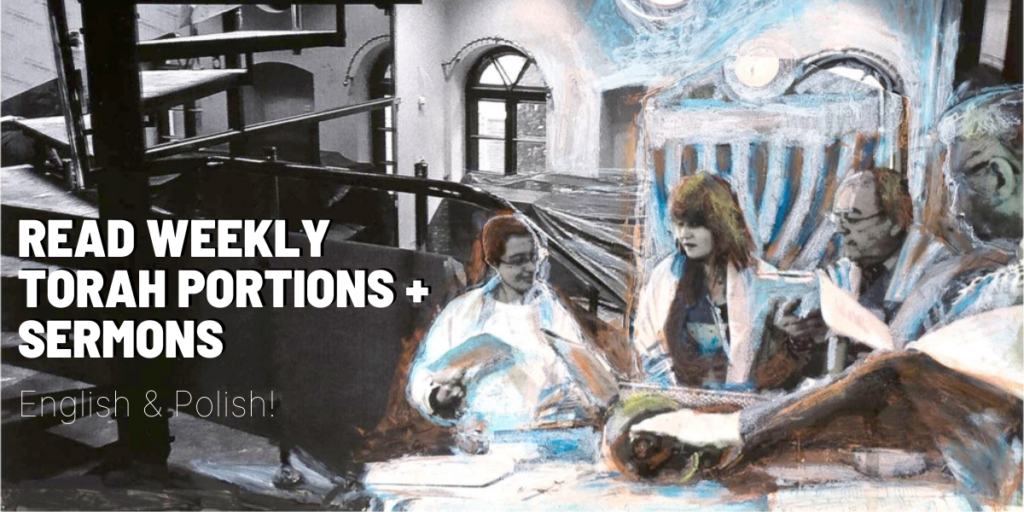
Menachem Mirski
Thoughts on Parashah Vayishlach
Jacob sent messengers ahead to his brother Esau in the land of Seir, the country of Edom, and instructed them as follows, “Thus shall you say, ‘To my lord Esau, thus says your servant Jacob: I stayed with Laban and remained until now; I have acquired cattle, asses, sheep, and male and female slaves; and I send this message to my lord in the hope of gaining your favor.’” The messengers returned to Jacob, saying, “We came to your brother Esau; he himself is coming to meet you, and there are four hundred men with him.” (Gen 32:4-7)
In this week’s Torah portion the story of Jacob and Esau continues. The conflicted brothers are reconciled. However, before that happens, some significant events take place. Jacob is frightened upon hearing the message quoted above, which he received from the messengers (the angels.) He finds relief from fear in prayer – a prayer with a petition for God to protect him from the wrath/death at the hands of his own brother.
Did Jacob’s prayer work? We can assume – in analogy to other Biblical narratives – that Esau was marching along with four hundred men in order to seek revenge and to defeat his brother, but ultimately the Biblical narrative does not clearly state his intents. Esau greets Jacob, embracing him and kissing him in the presence of these four hundred men, and of course causes him no harm. (Gen 33:1-4)
A second crucial and famous occurrence – the nocturnal struggle of Jacob with an angel (a divine being or God Himself) – sheds some light on the above mentioned events.
Said the other, “What is your name?” He replied, “Jacob.” Said he, “Your name shall no longer be Jacob, but Israel, for you have striven with beings divine and human, and have prevailed.” (Gen 32:28-29)
The juxtaposition of these themes – Jacob’s prayer, his wrestling with God and his reconciliation with Esau – suggests that there is a connection between all of them. Jacob’s fight and victory had changed the course of events; at the same time, the fact that Jacob had prevailed over both humans and God meant that the world had accepted his will, and therefore his brother Esau did so as well.
This story has provided the foundations for a certain unique model of religious faith which is characteristic for Judaism and which emphasizes the motif of human beings fighting and wrestling with God. Indeed, the notion of challenging the existing world order and of disagreeing with the reality we find ourselves in is at the very core of our religion. Judaism does not accept and has never accepted the concept of the inevitably tragic nature of human existence, especially in its cosmological dimension, as it was done by various Greek schools of thought. In addition, the idea of celebrating defeats and tragedies plays only a marginal role in our ethos, despite a great number of such events in our history. God intended for us to live a life full of happiness and blessings. If the reality we are facing is different, it means that there is “something wrong” with the world we live in. Accepting a negative state of affairs is tantamount to a rejection of our mission to make the world a better place and it bears the hallmarks of idolatry.
This being said, there is more to our religious faith than just the idea of wrestling with God or the idea of our obedience to Him, while both of them are indeed its important components. In certain situations we must accept what we’ve been given by God, but in some other cases we have the right to wrestle with Him. One example could be our approach towards the Torah – the Written Torah and the Oral Torah. We’ve taken upon us the Written Torah on Mount Sinai and this is an undisputable fact – we’ve accepted it and we cannot back out of it. On the other hand, the development of the Oral Torah represents a certain kind of wrestling with the Written Torah. We accept our identity, history and heritage, but at the same time we are forced to wrestle with them and this wrestling is also a part of our heritage.
Translated from Polish by: Marzena Szymańska-Błotnicka
Walka czy Posłuszeństwo?
Refleksje nad Paraszą Wajiszlach
I wysłał Jakób posłańców przed sobą do Esawa, brata swego, do ziemi Seir, do dziedziny Edomu. I rozkazał im, i rzekł: „Tak powiedzcie panu mojemu Esawowi: tak rzecze sługa twój Jakób: u Labana gościłem i bawiłem dotąd. Ale nagromadziły się u mnie woły i osły, trzody, sługi i służebnice; a posyłam oznajmić to panu mojemu, by znaleźć łaskę w oczach twoich.” I wrócili wysłańcy do Jakóba i rzekli: „Przybyliśmy do brata twojego, do Esawa, a on również idzie na spotkanie twoje, a czerysta ludzi z nim.” (Genesis 32:4-7, tłum. I. Cylkow)
W paraszy na ten tydzień znajdujemy ciąg dalszy opowieści o Jakubie i Ezawie. Dochodzi do pojednania skonfliktowanych braci. Zanim to jednak następuje, mają miejsce pewne istotne wydarzenia. Jakub przeraził się powyższą wiadomością, którą otrzymał od posłańców (aniołów). Ucieczkę od trwogi znajduje w modlitwie, modlitwie z petycją, aby Bóg uchronił go od gniewu/śmierci z rąk własnego brata.
Czy modlitwa Jakuba zadziałała? Możemy, poprzez analogię z innymi opowieściami biblijnymi, domyślać się, iż Ezaw szedł wraz czerystoma ludźmi po to aby zemścić sie i pobić swojego brata, jednakże opowieść biblijna ostatecznie nie wyjawia nam jasno jego zamiarów. Ezaw wita Jakuba, obejmując go i całując wśród owych czterystu ludzi, nie zadając mu, rzecz jasna, żadnej krzywdy. (Gen 33:1-4).
Pewne światło na tę kwestię rzuca drugie istotne i zarazem słynne wydarzenie, a mianowicie nocna walka Jakuba z aniołem (istotą boską lub samym Bogiem):
I rzekł do niego: „Jakie imię twoje?” I odpowiedział: „Jakób.” I rzekł: „Nie Jakób będzie nazywane odtąd imie twoje, ale Israel; gdyż walczyłeś z istotą boską i z ludźmi, i przemogłeś”. (Gen 32:28-29, tłum. I. Cylkow)
Zestawienie tych wątków – modlitwy Jakuba, walki z Bogiem oraz pojednania z Ezawem – sugeruje, iż istnieje pomiędzy nimi związek. Walka i wygrana Jakuba zmieniła bieg rzeczy; fakt, iż Jakub przemógł i ludzi, i Boga oznacza jednocześnie, iż świat zaakceptował jego wolę, a tym samym uczynił to jego brat Ezaw.
Historia ta stworzyła podwaliny pod pewien wyjątkowy model religijnej wiary, charakterystyczny dla judaizmu, akcentujący wątek walki, mocowania się człowieka z Bogiem. W istocie, kwestionowanie istniejącego porządku świata, niezgoda na panującą rzeczywistość, przynależy do rdzenia naszej religii. Judaizm nie akceptuje i nigdy nie zaakceptował idei nieuchronnego tragizmu ludzkiej egzystencji, zwłaszcza w wymiarze kosmicznym, jak czyniły to różne prądy w myśli greckiej. Także wątek celebrowania klęsk i tragedii jest w naszym etosie czymś marginalnym, pomimo nagromadzenia ich w naszej historii. Bóg powołał nas do życia w szczęściu i błogosławieństwie. Jeśli sprawy się mają inaczej, oznacza to, że coś jest „nie tak” z istniejącym światem. Akceptacja istniejącego, „złego stanu rzeczy” jest symptomem odrzucenia naszej misji czynienia świata lepszym i nosi znamiona idolatrii.
Jednakże nasza religijna wiara nie streszcza się wyłącznie ani w mocowaniu się z Bogiem, ani w posłuszeństwie wobec Niego – oba modele są jej istotnym komponentem. Istnieją sytuacje w których musimy zaakceptować to, co zostało nam dane od Boga, jak również takie, w których mamy prawo się z nim mocować. Jednym z przykładów może tu być nasz stosunek do Tory – Tory w Piśmie i Tory Ustnej. Torę w Piśmie przyjęliśmy na Górze Synaj i jest to fakt nie podlegający dyskusji – zaakceptowaliśmy ją i nie możemy się z tego wycofać. Jednakże rozwój Tory Ustnej stanowi swoiste mocowanie sie z Torą w Piśmie. Akceptujemy naszą tożsamość, historię i dziedzictwo, lecz jednocześnie jesteśmy zmuszeni do mocowania się z nimi i to mocowanie się również stanowi część naszego dziedzictwa.


















Leave a Reply